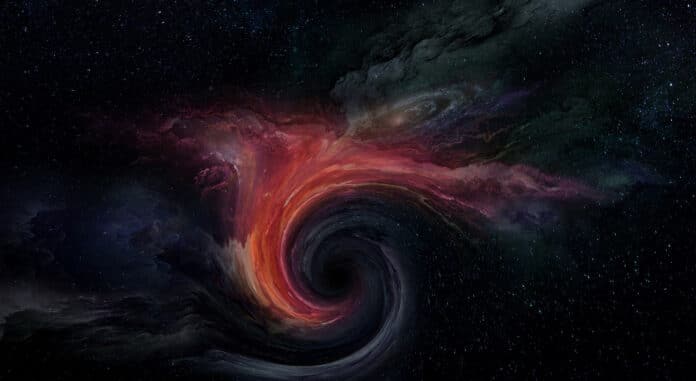Astronomers have observed a supermassive black hole moving through space without a home galaxy
Along the way, the giant is creating shock waves and triggering star formation.
Researchers from Canada, Australia, and the United States have found evidence of a rogue supermassive black hole that is tearing through space and interacting with the circumgalactic medium, causing shock waves and starting star formation. Detecting such runaway SMBHs is challenging, but crucially important.
There are various ways for a supermassive black hole to escape from the center of a galaxy, starting with a galaxy merger that results in a binary SMBH. If a third SMBH reaches the galaxy’s center before the binary merges, a three-body interaction can give a significant velocity to one of the SMBHs, leading to its escape from the nucleus.

Locating rogue SMBHs is challenging, despite their theoretical foundations. In 2021, astronomers discovered one contender, located 230 million light-years away, through unusual movement and speed indicating a recent disruption. However, it is unclear whether it was a gravitational wave recoil event, a double black hole system, or an ongoing galaxy merger.
There are a few ways for astronomers to spot a runaway SMBH. The simplest method is to recognize it by its luminosity as an active galactic nucleus that absorbs material. However, determining whether they are “naked” black holes or the nuclei of merging galaxies can be difficult.
Another way is through the star mass that the rogue hole pulls behind it. When an SMBH is ejected, some stars are drawn along by its powerful gravitational force. However, distinguishing the hole and its star companions at a distance is challenging due to the lack of an AGN’s luminosity.
A third technique for identifying a suspected rogue SMBH is its impact on diffuse gas in the circumgalactic medium (CGM) as it passes through it.
Scientists noted, “The interaction of a runaway supermassive black hole with the CGM can lead to the formation of a wake of shocked gas and young stars behind it. Their paper reports the serendipitous discovery of a linear feature in images from Hubble’s Advanced Camera for Surveys that could be one of these wakes.”
As researchers explained, it can be challenging to identify rogue SMBHs despite their theoretical foundation. In 2021, however, astronomers discovered a promising candidate located 230 million light-years away, as they observed unusual movement and speed indicating recent disruption. The team could not determine whether they had observed a gravitational wave recoil event, a double black hole system, or an ongoing galaxy merger.
To identify a runaway SMBH, astronomers can use various methods, such as observing the luminosity of an active galactic nucleus or detecting the star mass that the rogue hole pulls behind it. Another technique is to examine the impact of a suspected rogue SMBH on the diffuse gas in the CGM as it passes through it.
When an SMBH moves through ionized hydrogen in the CGM, it creates a shock front and a substantial wake. Clouds of shocked gas can cool and form stars that resemble knots in the trail in the aftermath. By examining three of the knots, the scientists determined their ages and metallicities, which fell within the suggested age range and attributes.
If the host galaxy ejected an SMBH, it should show signs of disruption. The team examined the galaxy that produced the rogue SMBH and found its morphology disrupted. The researchers settled on the runaway SMBH as the best explanation for the data and observations.
While the black hole jet explanation is possible, it has too many issues, such as the lack of visible emission lines and no evidence of nuclear activity. The morphology of the feature also does not match simulations or observations of jet-induced star formation.
However, researchers noted that locating the black holes would provide incontrovertible evidence for their conclusion, as the “smoking gun” evidence for this scenario would be the unambiguous identification of the black holes themselves. These candidates are for “hyper-compact stellar systems,” which are SMBHs enveloped in stars and gas that escaped with them.
Looking ahead, future data from the Nancy Grace Roman telescope can be searched with automated algorithms, and deeper data from the JWST NIRSPEC IFU could provide evidence of ionized gas bound to the black holes. Additionally, as the morphology of the feature is striking, it should not be too difficult to find more examples if they exist.
Journal Reference:
- Pieter van Dokkum et al., A candidate runaway supermassive black hole identified by shocks and star formation in its wake, arXiv (2023). DOI: 10.48550/arxiv.2302.04888
Do not forget to share your opinion with us to provide you with the best posts !



0 Comments